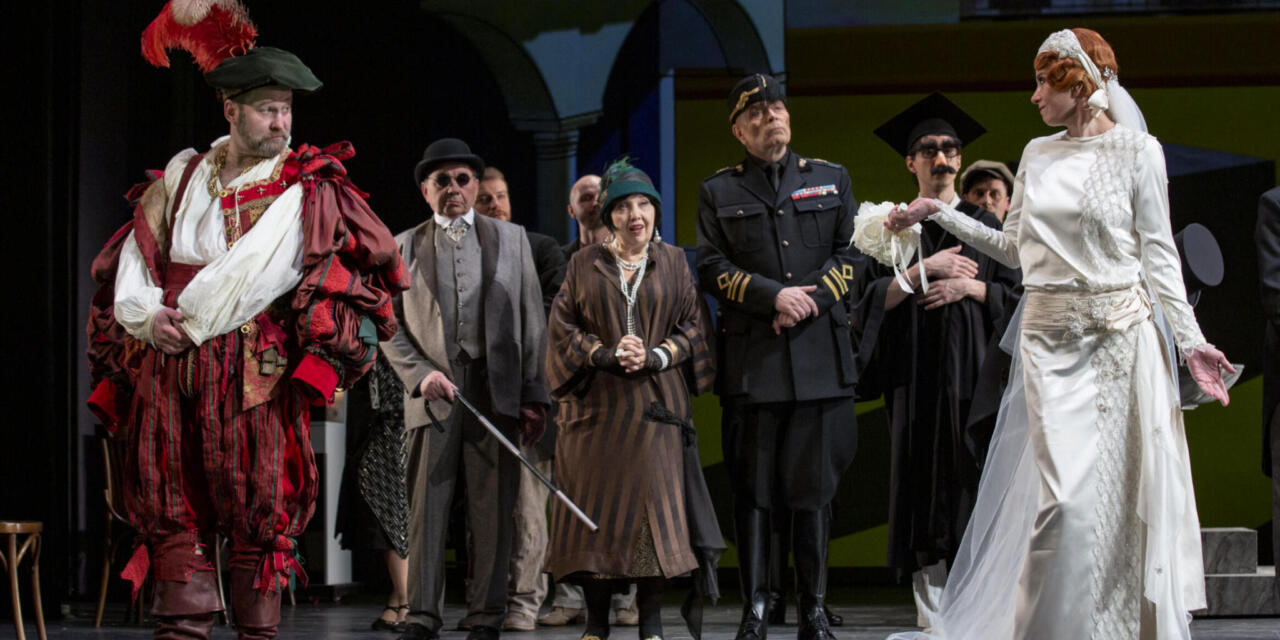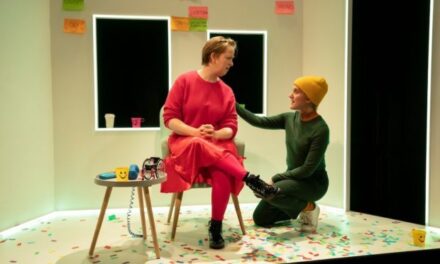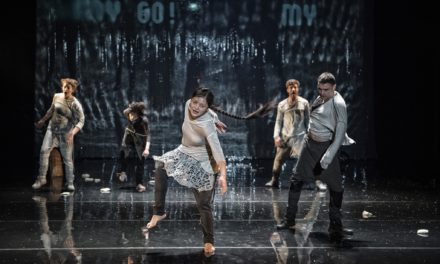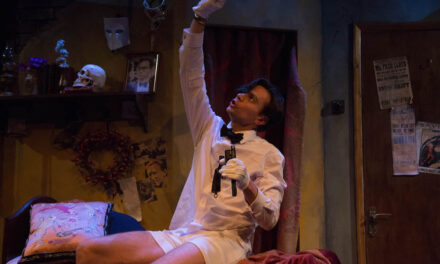In a country at war, theatres continue to work…
“(They) are so simple to offer war where they should kneel for peace,” phrases torn out of the context of works acquire a new tone in the context of modernity. This line, which was heard at the Mossovet Theater in Andrei Konchalovsky‘s 2014 touring production of The Taming of the Shrew by the Teatro Stabile Napoli, did not evoke the same feelings as those that arise in the audience when they hear it in 2022 from the same theatre in the same director’s production of the same play. The stage, the scenography, and the mise en scène are all the same. This Moscow premiere is in fact and in form the author’s reproduction of the play presented in Italy in 2013 and in Moscow a year later. A sort of theatrical “import substitution”: the Russian actors are trying not so much to resemble Shakespeare’s characters, as to fit into the Italian ready-made dress. This dress is reasonably well made (in Italy the performance was received favorably), but not according to the actor’s “figure”, who is now wearing it on the stage in Moscow. What was appropriate under the sun of Naples (at a theatre festival), withers in the Moscow off-season and there are more reasons than excuses for this.
The twenties of the 21st century often remind one of the twenties and thirties of the 20th. Here Andrei Konchalovsky has turned back the clock on a play written in the late 16th century to Mussolini’s Italy several centuries earlier. Why? “First of all, it’s beautiful,” (“Be silent and admire” sounds from the stage), and that’s all. The director has produced a downright “regime performance”: No, not denouncing the regime, but existing in full harmony with it, whatever century and whatever country you take. What is “fascism in Italy” for some people is merely a delightful era for others – and Andrei Konchalovsky is one of them. As the Russian poet Alexander Blok wrote: “Erase random features” (racial laws, repression, and “all this”)” and you will see: the world is beautiful. An alluring time corresponds to Shakespeare: at the Theatre Invictus in Chicago, for example, The Merchant of Venice was transferred to the same era as Loredana Scaramella at the Globe in Rome, who chose the same time period for her Taming of The Shrew. Both of these adaptations are dictated not by aesthetics, but by the ethics of the time, by the desire to speak from the stage about anti-Semitism and the oppression of women. Konchalovsky’s production, however, seems dictated by the “idiotic” (taken from Dostoevsky’s novel The Idiot) idea: “Beauty will save the world.” Yet dolefully, it does not save the performance.
In interviews and in the author’s comments on the theatre’s website, the director often quotes Alexander Pushkin: “Laughter, pity, and horror are the three strings of our imagination, shaken by dramatic magic.” For Konchalovsky, it is not the thought that is important in a play, but the emotion. In The Taming of the Shrew they do everything to entertain the audience: gags, ridiculous wigs, and makeup, grimaces, motley colours, sitcom mise-en-scenes with clowning and buffoonery in abundance. Except that the audience laughs, which is not squeezed out. And that’s because Pushkin was right when he continued with the director’s torn-off line: “But laughter soon gets weaker, and it is impossible to base a complete dramatic action on it alone”. And so, the Russian copy of the Italian production crumbles before our eyes, just as the beauty of Italy crumbled at the time of its history, so much appreciated by Konchalovsky.
The director has not only cut down Pushkin’s thought, but also Shakespeare’s play. The life-size cabriolet fits on stage, but the text of the play does not. The author’s staging is the director’s undoubted right, but it’s rather strange to see an important part for its theatrical nature – the introduction – removed from the play. It tells us that a certain Lord has decided to play a joke on the drunkard Sly. He has persuaded servants and strolling actors to convince the poor man that he is a noble lord suffering from insanity. For “lord” Sly and for the audience actors, according to Shakespeare, and play, the plot of which, fits into its title: The Taming of the Shrew. The play is essentially a play within a play in which everyone is not what they seem and everyone plays more than one part. The farcical devices here enlarge the vices of society to best address them from the stage and in themselves. The “crooked mirror” of comedy in the play becomes a mirror for the audience. There is a mirror in Konchalovsky’s play, too, but it is not directed at the audience and serves solely for the actor’s narcissism.
The play is as dressed up as the actors. The backdrop is a screen on which appears a video installation with the architectural geometry of De Chirico, Dali, and Italian rationalism. There is even a drinking fountain on stage, but the performance itself, alas, is no fountain. Water flows, much like the stage time…very, very slowly. Almost three hours of this play feels like five acts of another play. A gramophone plays nostalgic Italian tunes like Alberto Rabagliati and Vittorio De Sica’s Speak to Me About Love, Maria, while the actors act out Italian life, trying to imitate the stylistics of Commedia dell’arte. But just as the carnival goggles used in the play, with the mustache and nose attached, resemble exquisite Venetian masks, so the actors’ grimaces relate to the Italian school of mask-wielding. One can learn the mise en scène of an Italian “single-blooded” play (the actors were guided by the director’s first production recording during rehearsals) and see Giorgio Strehler’s Harlequin, Servant of Two Masters hundreds of times, but all these efforts, alas, cannot replace the school and skill that are necessary for Commedia dell’arte. The competitive spirit, however, motivates and inspires the actors. Thus, in the pre-premiere interview, Alexander Bobrovsky, the performer of Hortensio, unequivocally formulated his martial, in the spirit of the time, attitude: “We will outplay them in any way we can. “Them” means the Italians. The primitive duality of worldview with its indispensable “us” and “them”, “our own” and “alien” has penetrated into the space of the theatre. However, we must give credit to the actor, he kept his word: the words and gestures are overplayed, overdramatized, and caricatured.
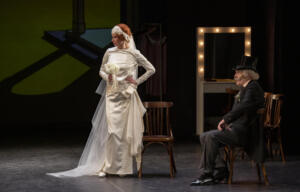
The Taming of the Shrew. Katharina – Julia Vysotskaya, Baptista – Alexander Filippenko. Photo: Elena Lapina.
It is a shame that the lighter Italian production about the marriage transaction between two idiots in Russia turned out to be an awkward and vulgar joke. This and other Shakespearean plays are sometimes accused of misogyny, though The Taming of the Shrew allows for varied interpretations and a mockery of patriarchal stiffness. The finale of Konchalovsky’s Italian production, with Katharina’s textbook monologue of meekness and humility, sounds like a parody studded with provoked laughter. The final feast, however, was a “celebratory wake,” for an era when a woman’s virtue was mute. The finale of the Russian production is changed 180 degrees. It echoes the propaganda film The Taming of the Shrew, made under Mussolini in Italy in 1942, which asserts the absolute priority of the stable family and the submissiveness of the wife. The play by Shakespeare was directed by Ferdinando Maria Poggioli (who committed suicide in 1945) and transferred to the Italy of his day. In his contemporary Russia, Konchalovsky presents the ending as a fable moral.
The monologue of Katharina, performed by Julia Vysotskaya, sounds much like a sermon:
Thy husband is thy lord, thy life, thy keeper,
Thy head, thy sovereign; one that cares for thee, And for thy maintenance commits his body
To painful labor both by sea and land,
To watch the night in storms, the day in cold, Whilst thou liest warm at home, secure and safe; And craves no other tribute at thy hands
But love, fair looks and true obedience; Too little payment for so great a debt.
While the Italian production asserted an imaginary submission, the Russian production asserts that “traditional family values” are no cause for irony. The wife is the country, and the husband is the sovereign. The family is the bulwark of the state and a miniature model of society. The Taming of the Shrew, chosen by the director, may seem out of time, but it is in fact just in time. And it is not difficult to be convinced of that if you read an interview with the director who says, among other things, that “a normal woman does not want freedom” or “today teenagers – psychologically and intellectually immature people – rule in Europe,” but, as the author of the performance stipulates, “luckily I do not do politics and try to walk without looking around.” And it would be worthwhile to look around and see that today in Russian society, words are forbidden by law or substituted for their content. In this context, the scene of the play takes on a double meaning:
PETRUCHIO
Come on, i’ God’s name; once more toward our father’s. Good Lord, how bright and goodly shines the moon!
KATHARINA
The moon! the sun: it is not moonlight now.
PETRUCHIO
I say it is the moon that shines so bright.
KATHARINA
I know it is the sun that shines so bright.
PETRUCHIO
Now, by my mother’s son, and that’s myself, It shall be moon, or star, or what I list,
Or ere I journey to your father’s house. Go on, and fetch our horses back again.
Evermore cross’d and cross’d; nothing but cross’d!HORTENSIO
Say as he says, or we shall never go.
KATHARINA
Forward, I pray, since we have come so far, And be it moon, or sun, or what you please.
“War is peace, freedom is slavery, and ignorance is strength.” The come-true “Big Brother” casts a shadow on the audience’s perception of the Great Bard today. It is not through the books that the public knows Petruchio’s experience over Katharina, when he does not allow the obvious to be called by its own names. And all those passages about how, with good intentions, her husband starves his wife and does not let her sleep for the purpose of re-educating her, do not seem ridiculous or exaggerated after the numerous news reports of torture in Russia. The play, however, follows the tenet of “healthy fasting” that fasting is good for the body, just like abstinence. Conservative speeches from the 16th century to the 21st are presented here as truth, and remarks about freedom and the right to one’s own voice are mocked and ridiculed.
“I want freedom!” cries Katharina, stammering, fighting for a new hat. Apparently, the director thinks freedom is only advocated by people who are greedy for material gain. Freedom is nothing more than a whim, and fighting for it is the spawn of idleness. “In love and obedience humble yourselves!” the Vysotsky character addresses the audience, without a shadow of irony.
In the play, the motto “Universa universis patavina libertas” (Paduan freedom is universal for everyone) of the University of Padua (1222) has fallen. Its place is taken by the pale, lifeless moon, which the play tells us is the sun. The references to Fellini and his “Voice of the Moon” should be sent back to the same place to which Futurism, theatrical avant-garde, biomechanics, Pirandello’s “theater in theater”, and all that could fill the spectacle that had thrown over the bridge into the Italy of the 1920s-30s went. De Chirico’s surrealism, borrowed in the design, degenerated into surrealism, and the ironic and inventive comedy became a play of dress code and dressage. “I want! I can! I will!”, a line that is absent from the play’s author, but which seems to have become the credo of the play’s director, sounds from the stage.
It all sounds rather acidic.
This post was written by the author in their personal capacity.The opinions expressed in this article are the author’s own and do not reflect the view of The Theatre Times, their staff or collaborators.
This post was written by Emiliia Dementsova.
The views expressed here belong to the author and do not necessarily reflect our views and opinions.

